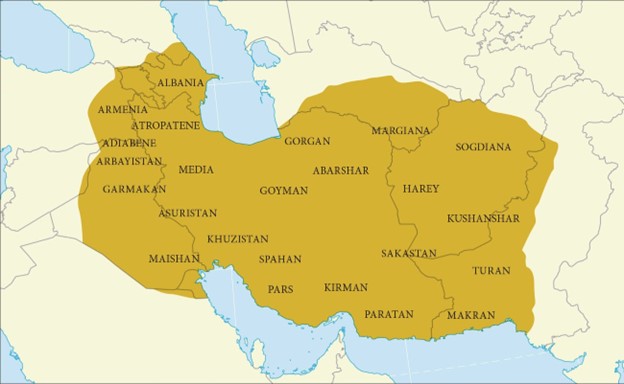27 Persia in Late Antiquity
As noted in the previous chapter, following Alexander the Great’s conquest of the Achaemenid Persian Empire in the 4th century BCE, the Seleucid dynasty governed much of his eastern territory. However, by the 3rd century BCE, the Parthians, a local tribe along the east coast of the Caspian Sea, began to challenge Seleucid rule. The Parthians established a decentralized government with semi-autonomous rulers managing various districts. They maintained an extensive trade network built on the infrastructure developed during the Seleucid period. The Parthians’ highly skilled cavalry enabled them to secure numerous victories against the Roman Empire.
Despite their military successes, the Parthians faced significant challenges, including Roman expansion into their territory, such as Mesopotamia, by the 2nd century CE. This led to the rise of the Sasanian Empire in 224 CE, founded by Ardashir I (r. 224–241 CE). The Sasanians were engaged in continuous conflict with the Romans and other neighboring groups, striving to defend and consolidate their empire’s borders. Notable events during this period included the capture of Roman Emperor Valerian in 260 CE and the fortification of the empire’s frontiers against nomadic groups like the Huns.

The Sasanian ruler, known as the “King of Kings,” presided over a centralized state, with local officials reporting directly to him. The empire stretched from modern-day Georgia to the Indus River, encompassing both urbanized centers and nomadic tribes. The Sasanians utilized their strategic position between the Roman Empire and China to facilitate trade, extending their trade network well beyond their borders.
The Sasanian Empire was culturally and linguistically diverse, with a hierarchical class structure prominent in urban areas. Women’s legal status was relatively low, with many laws regulating their behavior; however, they could inherit property and engage in some business activities. The state employed various forms of punishment to maintain order, often linked to violations of the principles of Zoroastrianism, the state religion instituted by Ardashir I. Zoroastrianism emphasized loyalty to the government and the royal family, encouraging adherents to practice good deeds, hold good thoughts, and perform rituals of purification.
In the sixth and seventh centuries, the Sasanian Empire faced its longest period of sustained conflict with the Eastern Roman Empire, a powerful state that controlled a vast territory to the east and was also known as the Byzantines. This period of conflict saw skilled military leaders on both sides, including Khosrow I (r. 531-579), who successfully repelled several nomadic incursions into the Sasanian Empire and negotiated a peace treaty with the Byzantines in 532. However, this peace was short-lived, and Khosrow I took advantage of their distraction with internal conflicts to expand the Sasanian Empire westward into Byzantine territory.
The truce signed in 557 was short-lived, and hostilities resumed after the Byzantine emperor Justinian passed away in 565. Khosrow II (r. 590-628), the last great Sasanian king, initially enjoyed a friendly relationship with the Byzantines, having regained his throne with their aid. However, when the Byzantine emperor Maurice was murdered, Khosrow II used this as a pretext to invade Byzantine territory in 602. The Sasanian Empire once again occupied key regions, including Armenia and Syria, and extended its reach into Palestine, Egypt, and even Libya by 619.
Despite the hostilities, the Sasanian Empire maintained a complex relationship with the Byzantines, marked by cultural exchange and shared court rituals. They exchanged gifts, observed processions and games, and communicated regularly through embassies, even during times of conflict. Both empires recognized each other’s legitimacy as rival states, and they adopted similar methods of symbolic communication. In this period of prolonged conflict, the Sasanian Empire also utilized smaller states as proxies in their conflicts. The Armenians, despite religious differences, often sought Sasanian assistance, and the Sasanians skillfully played different nomadic groups against each other.
Life for ordinary people in Sassanid Persia (224–651 CE) was shaped by a rigid social hierarchy and diverse occupations. Most men worked as farmers, laborers, or artisans, while some served in the military or as merchants. Women were primarily responsible for managing households and raising children, though some participated in textile production and small-scale trade. Family life centered around strong patriarchal structures, with fathers holding significant authority. Zoroastrianism, the dominant religion, played a major role in daily life, influencing both personal conduct and social norms. Religious rituals and festivals were common, and priests, known as magi, held considerable power in guiding spiritual and political matters.
The Sasanian Empire began to decline in the seventh century CE. The empire struggled with internal conflicts, including power struggles between rival factions and regional governors, which weakened its central authority. External pressures also increased, particularly from the Byzantine Empire and the rapidly expanding Arabian tribes to the south. The Arabian tribes posed a significant threat to the Sasanian Empire’s southern borders. The decisive defeat of the Sasanians at the Battle of Qadisiyah in 636–637 CE marked a turning point that contributed significantly to the empire’s downfall.
To understand the complex dynamics leading to the rise of new powers in the region, it’s important to consider the historical context of the Arabian Peninsula during the early medieval period. While Saudi Arabia as a modern political entity did not exist at that time, the Arabian Peninsula’s tribal dynamics and cultural exchanges were crucial in facilitating the Arab conquests of the seventh century. Examining this context helps illuminate the social, economic, and political factors that contributed to the Sasanian Empire’s decline and the emergence of new powers in the region. Understanding these factors provides a deeper insight into this pivotal moment in world history.
